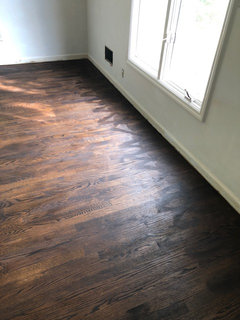Edger marks on hardwoods AFTER staining
Can I get them out without re-sanding and re-staining the whole floor??
We just bought a 60 year old house that had carpet over what we think is red oak floors. The house was vacant for 1.5 years. I took it upon myself to try my hand at sanding and staining these floors back to life. They looked decent until the end, when we saw the edges start to pop from the stain. Where I took the edger with the grain, perpendicular to the wall, it left very obvious swirls all along the wall. Is there anyway to spot sand this and blend with a re-stain? If so, what do I use? Orbital? What grit? fingers crossed...
THANK YOU!
Comentarios (13)
- hace 5 añosMatt, is this the whole edge or limited areas? My floor guy uses a VERY sharp scraper to remove the finish and the swirls from a bad board, then stains and polys that board. We always do this after the first coat of poly so then everything gets a unifying coat. If this is the entire edge of the room it will probably be best (I did not say easiest or fastest) to re sand the whole floor.0
- hace 5 añosI wonder if the edger was set up properly. Since my antique edger gave up the ghost, we have rented an edger for the handful of projects we have done in the past few years. My partner has found that many of the rental machines are not set at the proper height and sometimes the pads are in poor condition. The folks at the rental counter may have not ever done a floor themselves so they won't be a good source of info about the use of the machine. Search the web as there is some good info available on setting up and operating the equipment.
Buy a good quality scraper and a file to keep it sharp for the corners. After the final pass with the edger, do the corners and go around the perimeter with a piece of sandpaper and sand out whatever edger marks you see. Old edger paper folded in half is what we usually use. Dark stain shows all the issues with the sanding work so it is a tossup, darker tone is better for hiding spots and marks on the floor but lighter or no stain at all is better for hiding sanding issues. - hace 5 años
Festool Rotex 150 on grind mode with an 80 grit paper and those marks will be gone quickly . Switch to random orbital and a gradually higher grit protocol until the marks are gone.
Matt Faley
Autor originalhace 5 añosJoseph - will it be OK to use this method by only sanding out the edges and blending in new stain or should I still re-sand the whole floor?
G + S - I went 36, 60, 80 with the drum sander
Thanks all who have posted. Extremely helpful.0- hace 5 añosÚltima modificación: hace 5 años
You’re gonna have a demarcation line between the areas of you don’t sand the whole. A good Pro could get away without resanding the whole. And it would still be best to hire one rather than take off more life from your floors. Amateurs tend to sand to shallowly, or to sand too deeply, and remove more than is needed. Then the first scenario ends up as the second scenario to fix the first.
Refinishing floors just isn’t that expensive to not hire a Pro. Especially compared with what the mistakes cost you.
- hace 5 años
You can palm sand the edge with 80, then chase the grain with 80. Make sure you use the same type of minerals, then re-stain.
0

Volver a cargar la página para no volver a ver este anuncio en concreto

National Hardwood Flooring & Supplies